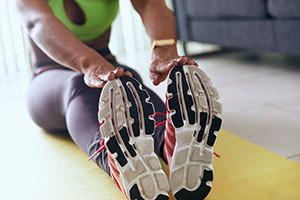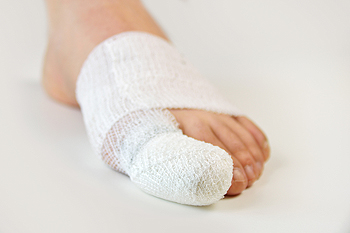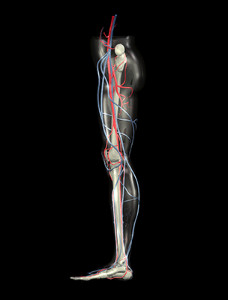Connect With Us
Blog
Items filtered by date: August 2019
Stretching and the Prevention of Running Injuries
 Many runners are familiar with the pain and discomfort a running injury can cause. It is beneficial to practice an adequate warm up routine before embarking on a running adventure, as this may help to prevent unwanted running injuries. When the legs are strong, the chances of incurring a running injury may be diminished. This can be accomplished by performing stretches that can strengthen the legs. Additionally, many runners and joggers find it beneficial to use a foam roller on their calves, as this may help to alleviate the pain that can come from sore and tight muscles. If you would like additional information about how to prevent running injuries, it is suggested that you consult with a podiatrist.
Many runners are familiar with the pain and discomfort a running injury can cause. It is beneficial to practice an adequate warm up routine before embarking on a running adventure, as this may help to prevent unwanted running injuries. When the legs are strong, the chances of incurring a running injury may be diminished. This can be accomplished by performing stretches that can strengthen the legs. Additionally, many runners and joggers find it beneficial to use a foam roller on their calves, as this may help to alleviate the pain that can come from sore and tight muscles. If you would like additional information about how to prevent running injuries, it is suggested that you consult with a podiatrist.
Exercising your feet regularly with the proper foot wear is a great way to prevent injuries. If you have any concerns about your feet, contact Tanisha Richmond, DPM of Richmond Foot & Ankle, LLC. Our doctor will treat your foot and ankle needs.
How to Prevent Running Injuries
Many common running injuries are caused by overuse and overtraining. When the back of the kneecap starts wearing out and starts causing pain in your knee, this is commonly referred to as runner’s knee. Runner’s knee is a decrease in strength in your quadriceps and can occur if you’re not wearing properly fitted or supporting shoes. To prevent runner’s knee, focusing on hip strengthening is a good idea, as well as strengthening your quads to keep the kneecaps aligned.
What Are Some Causes of Running Injuries?
- One cause of a common running injury is called iliotibial band syndrome.
- Plantar fasciitis is also another common injury.
- Stress fractures can occur from overtraining, lack of calcium, or even your running style.
Best Ways to Prevent Running Injuries
- Wear footwear that fits properly and suits your running needs.
- Running shoes are the only protective gear that runners have to safeguard them from injury.
- Make a training schedule. Adding strengthening exercises as well as regular stretching can help keep you strong and limber and can lessen the possibility of injuries.
- Stretching keeps muscles limber; this will help you gain better flexibility.
If you have any questions please feel free to contact our office located in Dayton, OH . We offer the newest diagnostic and treatment technologies for all your foot and ankle needs.
Why Live with Pain and Numbness in Your Feet?
What Causes Gout?
 Elevated uric acid levels in the bloodstream may lead to a painful condition that is known as gout. It typically affects the joints in the big toe, and symptoms generally consist of swelling, redness, and severe pain and discomfort. It can occur as a result of crystals that form and lodge in the joints, which is caused by eating foods that have high purine levels. These foods can include red meat, shellfish, and excess amounts of alcohol. After a proper diagnosis is performed, which can consist of extracting fluid from the affected joint that contains the crystals, proper treatment can begin. This can include taking medication which can lower uric acid levels. There are methods that can be implemented which may prevent gout attacks from occurring. It is beneficial to incorporate healthy eating habits into your daily routine, and limiting the amount of alcohol that is consumed. If you have frequent gout attacks, it is suggested that you consult with a podiatrist who can treat this condition.
Elevated uric acid levels in the bloodstream may lead to a painful condition that is known as gout. It typically affects the joints in the big toe, and symptoms generally consist of swelling, redness, and severe pain and discomfort. It can occur as a result of crystals that form and lodge in the joints, which is caused by eating foods that have high purine levels. These foods can include red meat, shellfish, and excess amounts of alcohol. After a proper diagnosis is performed, which can consist of extracting fluid from the affected joint that contains the crystals, proper treatment can begin. This can include taking medication which can lower uric acid levels. There are methods that can be implemented which may prevent gout attacks from occurring. It is beneficial to incorporate healthy eating habits into your daily routine, and limiting the amount of alcohol that is consumed. If you have frequent gout attacks, it is suggested that you consult with a podiatrist who can treat this condition.
Gout is a painful condition that can be treated. If you are seeking treatment, contact Tanisha Richmond, DPM from Richmond Foot & Ankle, LLC. Our doctor will treat your foot and ankle needs.
What Is Gout?
Gout is a form of arthritis that is characterized by sudden, severe attacks of pain, redness, and tenderness in the joints. The condition usually affects the joint at the base of the big toe. A gout attack can occur at any random time, such as the middle of the night while you are asleep.
Symptoms
- Intense Joint Pain - Usually around the large joint of your big toe, and it most severe within the first four to twelve hours
- Lingering Discomfort - Joint discomfort may last from a few days to a few weeks
- Inflammation and Redness -Affected joints may become swollen, tender, warm and red
- Limited Range of Motion - May experience a decrease in joint mobility
Risk Factors
- Genetics - If family members have gout, you’re more likely to have it
- Medications - Diuretic medications can raise uric acid levels
- Gender/Age - Gout is more common in men until the age of 60. It is believed that estrogen protects women until that point
- Diet - Eating red meat and shellfish increases your risk
- Alcohol - Having more than two alcoholic drinks per day increases your risk
- Obesity - Obese people are at a higher risk for gout
Prior to visiting your podiatrist to receive treatment for gout, there are a few things you should do beforehand. If you have gout you should write down your symptoms--including when they started and how often you experience them, important medical information you may have, and any questions you may have. Writing down these three things will help your podiatrist in assessing your specific situation so that he or she may provide the best route of treatment for you.
If you have any questions, please feel free to contact our office located in Dayton, OH . We offer the newest diagnostic and treatment technologies for all your foot care needs.
What Is Buddy Taping?
 The first symptom many people experience if they have broken their toe is severe pain and discomfort. Other noticeable signs can include swelling, bruising on or around the affected toe, and difficulty walking. In severe fractures, patients may hear a popping sound as the break occurs. Common reasons for this type of injury to happen can include stepping unexpectedly off of a curb, hitting it against a piece of furniture, or it may gradually develop as a result of a stress fracture. Effective treatment options can include taping the affected toe to the toe next to it, which is referred to as buddy taping. This can be helpful in providing the necessary stability as the healing process occurs. Mild relief may be found when the foot is elevated, and this can be beneficial in reducing existing swelling. If you have broken your toe, it is suggested that you consult with a podiatrist who can suggest the proper treatment for you.
The first symptom many people experience if they have broken their toe is severe pain and discomfort. Other noticeable signs can include swelling, bruising on or around the affected toe, and difficulty walking. In severe fractures, patients may hear a popping sound as the break occurs. Common reasons for this type of injury to happen can include stepping unexpectedly off of a curb, hitting it against a piece of furniture, or it may gradually develop as a result of a stress fracture. Effective treatment options can include taping the affected toe to the toe next to it, which is referred to as buddy taping. This can be helpful in providing the necessary stability as the healing process occurs. Mild relief may be found when the foot is elevated, and this can be beneficial in reducing existing swelling. If you have broken your toe, it is suggested that you consult with a podiatrist who can suggest the proper treatment for you.
Broken toes may cause a lot of pain and should be treated as soon as possible. If you have any concerns about your feet, contact Tanisha Richmond, DPM from Richmond Foot & Ankle, LLC. Our doctor will treat your foot and ankle needs.
What Is a Broken Toe?
A broken toe occurs when one or more of the toe bones of the foot are broken after an injury. Injuries such as stubbing your toe or dropping a heavy object on it may cause a toe fracture.
Symptoms of a Broken Toe
- Swelling
- Pain (with/without wearing shoes)
- Stiffness
- Nail Injury
Although the injured toe should be monitored daily, it is especially important to have a podiatrist look at your toe if you have severe symptoms. Some of these symptoms include worsening or new pain that is not relieved with medication, sores, redness, or open wounds near the toe.
If you have any questions, please feel free to contact our office located in Dayton, OH . We offer the newest diagnostic and treatment technologies for all your foot care needs.
Do Your Child's Feet Hurt?
Symptoms and Causes of Poor Circulation
Poor circulation occurs when blood flow to a specific part of your body is reduced.  Several conditions such as heart disease, diabetes, and obesity, can all lead to poor circulation. Unhealthy behaviors can be attributing factors, including smoking cigarettes, lack of exercise, and having high cholesterol. Poor circulation in the feet can be caused by peripheral artery disease, or PAD. PAD is the result of a buildup of plaque in the arteries. Poor circulation is also known to cause muscle pain, stiffness, skin discoloration, and erectile dysfunction. People who have diabetes and smoke are at the greatest risk for poor blood circulation, as well as those who are over the age of 50. Exercising and maintaining a healthy lifestyle can drastically improve conditions. If you are experiencing complications from poor circulation in your lower extremities, it is advised that you consult with a podiatrist.
Several conditions such as heart disease, diabetes, and obesity, can all lead to poor circulation. Unhealthy behaviors can be attributing factors, including smoking cigarettes, lack of exercise, and having high cholesterol. Poor circulation in the feet can be caused by peripheral artery disease, or PAD. PAD is the result of a buildup of plaque in the arteries. Poor circulation is also known to cause muscle pain, stiffness, skin discoloration, and erectile dysfunction. People who have diabetes and smoke are at the greatest risk for poor blood circulation, as well as those who are over the age of 50. Exercising and maintaining a healthy lifestyle can drastically improve conditions. If you are experiencing complications from poor circulation in your lower extremities, it is advised that you consult with a podiatrist.
Poor circulation is a serious condition and needs immediate medical attention. If you have any concerns with poor circulation in your feet contact Tanisha Richmond, DPM of Richmond Foot & Ankle, LLC. Our doctor will treat your foot and ankle needs.
Poor Circulation in the Feet
Poor blood circulation in the feet and legs is can be caused by peripheral artery disease (PAD), which is the result of a buildup of plaque in the arteries.
Plaque buildup or atherosclerosis results from excess calcium and cholesterol in the bloodstream. This can restrict the amount of blood which can flow through the arteries. Poor blood circulation in the feet and legs are sometimes caused by inflammation in the blood vessels, known as vasculitis.
Causes
Lack of oxygen and oxygen from poor blood circulation restricts muscle growth and development. It can also cause:
- Muscle pain, stiffness, or weakness
- Numbness or cramping in the legs
- Skin discoloration
- Slower nail & hair growth
- Erectile dysfunction
Those who have diabetes or smoke are at greatest risk for poor circulation, as are those who are over 50. If you have poor circulation in the feet and legs it may be caused by PAD and is important to make changes to your lifestyle in order to reduce risk of getting a heart attack or stroke. Exercise and maintaining a healthy lifestyle will dramatically improve conditions.
As always, see a podiatrist as he or she will assist in finding a regimen that suits you. A podiatrist can also prescribe you any needed medication.
If you have any questions please feel free to contact our office located in Dayton, OH . We offer the newest diagnostic and treatment technologies for all your foot and ankle needs.
Blog Archives
- March 2025
- February 2025
- January 2025
- December 2024
- November 2024
- October 2024
- September 2024
- August 2024
- July 2024
- June 2024
- May 2024
- April 2024
- March 2024
- February 2024
- January 2024
- December 2023
- November 2023
- October 2023
- September 2023
- August 2023
- July 2023
- June 2023
- May 2023
- April 2023
- March 2023
- February 2023
- January 2023
- December 2022
- November 2022
- October 2022
- September 2022
- August 2022
- July 2022
- June 2022
- May 2022
- April 2022
- March 2022
- February 2022
- January 2022
- December 2021
- November 2021
- October 2021
- September 2021
- August 2021
- July 2021
- June 2021
- May 2021
- April 2021
- March 2021
- February 2021
- January 2021
- December 2020
- November 2020
- October 2020
- September 2020
- August 2020
- July 2020
- June 2020
- May 2020
- April 2020
- March 2020
- February 2020
- January 2020
- December 2019
- November 2019
- October 2019
- September 2019
- August 2019
- July 2019
- June 2019
- May 2019
- April 2019
- March 2019
- February 2019
- January 2019
- December 2018
- November 2018

